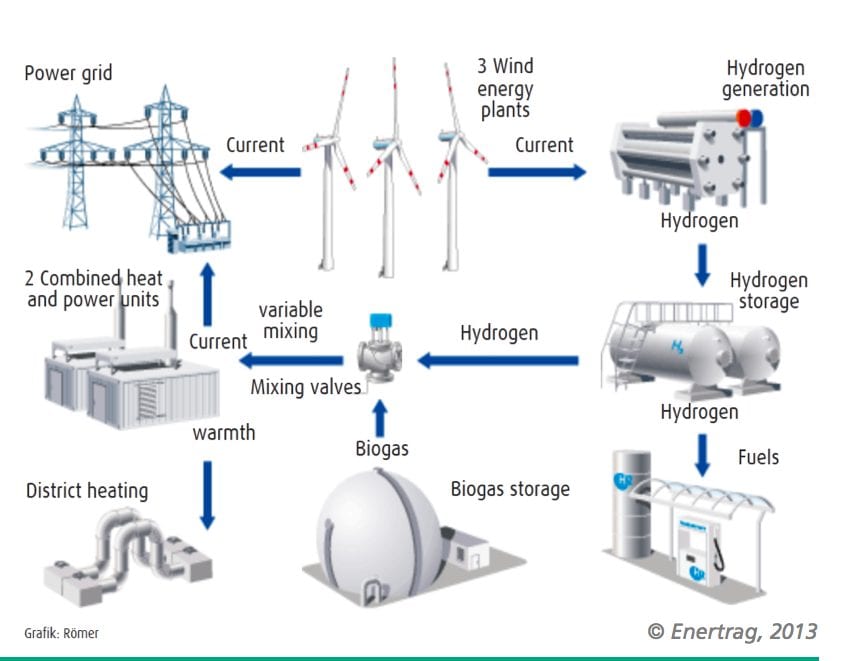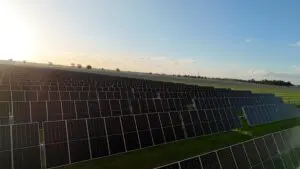Battery storage technologies seem to be the hot topic wherever you look in the energy industry. Germany is investing heavily into domestic storage, California has a huge mandate, and the market for peak shifting and storing production is gaining the interest of consumers, pro-sumers and network operators alike.
But can battery storage really solve some of the issues faced by the growing penetration of intermittent solar and wind technology? In the short term, it probably can, but as the penetration of renewables starts to grow in major economies, many think that battery storage will at such scale either simply be too expensive, or not have enough capacity to solve some of the long term issues.
Three new technologies are now emerging as potential long term solutions, and all argue that they will be cost competitive and even displace some of the gas generation that is normally assumed to fill the gaps.
Here’s a brief look at three of them:
Chemical Energy Storage
In Germany, there is a view that the only way to provide the amount of storage needed for a nearly fully renewable grid in the long term is through chemical means – and right now there are a bunch of projects that are looking how to apply electrolysis to turn excess output from wind and solar and other generation into hydrogen and methane.
At the Fraunhofer Institute for Solar Energy Systems in Frieburg, Dr Gunter Ebert says hydrogen and methane is the only option for large scale “season storage”. Battery can provide some short term storage capacity, maybe up to 50GWh – and so can pumped hydro (60GWh) – but he says the options are limited in Germany.
“We need a tremendous amount of long term storage – up to 70TWh,” Ebert told RenewEconomy in Frieburg last month. “That can only be done with hydrogen and methane.”
Ebert’s plan is to use caverns to store hydrogen, which can then me used for vehicles, or in fuel cells, or it can be converted into methane for use in the gas grid. Or it can be used for direct heat and power generation, as this rather complicated graph shows.
As Craig Morris reported on the Energiewende blog last week, the German company Thüga has exported the first hydrogen from electrolysis to the natural gas network. The firm says it plans to go into official operation at the beginning of 2014 after a test run. The practical test under operating conditions will last for nearly 3 years until the end of 2016. The unit under investigation has a power capacity of 315 kilowatts and can produce 60 cubic meters of hydrogen per hour.
Ebert says there are still many possibilities about how such a scheme could be put together – but some form of long term storage will be needed after 2020, when the share of renewables grows beyond 40 per cent, and more thermal generation is sidelined.
Compressed Air Energy Storage
 The second big technology that is being looked at is compressed air energy storage, known as CAES. The Boston-based firm General Compression last year opened a 2MW/500MWh pilot plant in Texas last year, and its representatives have made three trips to Australia this year to talk to utilities, renewable energy developers, and government representatives about their technology.
The second big technology that is being looked at is compressed air energy storage, known as CAES. The Boston-based firm General Compression last year opened a 2MW/500MWh pilot plant in Texas last year, and its representatives have made three trips to Australia this year to talk to utilities, renewable energy developers, and government representatives about their technology.
Development officer Peter Rood says CAES would work best at the utility-scale with 10MW to 100MW. It requires below ground storage – either natural or man-made – and could work with storing the output of wind energy, or even as a “storage bank” for thousands of rooftop and other distributed solar systems.
Rood told RenewEconomy during a visit to Australia last week that CAES will help wind energy act like a flexible gas-fired power station, providing base-load and peaking generation when needed – storing energy produced on some windy days for use later in the week – or even the month.
That means it would not only be able to mimic the services delivered by gas turbines, it would be able to compete with even combined cycle gas turbines as gas prices head above $10/mmbtu, where they are surely heading in Australia as the gas market heads towards export price parity.
“I think there will be a pretty compelling case to build wind plus storage,” he says, noting that a lot of thermal generation is ageing, and a renewables-focused energy system will need storage and other ancillary services, such as frequency, that such a system could provide.
General Compression is working on a rough formula of providing around 20-40 megawatt hours of storage for each MW of peak power production. Which means that for a 100MW wind project, the ideal would be to have a facility that could deliver between 200MWh and 400MWh of storage. CAES would be able to deliver this at a quarter of the price of battery technologies, says Rood.
General Compression also has a proposal for a “solar bank”, which would allow solar households to store excess energy, and either draw down that energy when needed, or sell it other users. (See more on that idea here).
General Compression has received some interesting funding to from the likes of oil giant ConocoPhillips and the largest utility in the US, Duke Energy.
Pumped Hydro
Another option is pumped hydro – a technology that is being pursued by the Melbourne Energy Institute and separately by the Australian National University. Australia already has some pumped hydro – it’s a key element of the Snowy River Hydro Scheme – but the new approach looks at siting pumped hydro storage away from natural water-courses and using natural contours to situate two reservoirs at different elevation that could be used to store energy – and negate the need to curtail output from wind farms.
 Andrew Blakers from the ANU, says there are numerous sites along the eastern seaboard, and elsewhere, that could lend themselves to pumped storage – and he is proposing a survey could be done to identify those sites. A joint study by the engineering and consulting company Arup and the University of Melbourne Energy Institute suggested that best technology may be pumping seawater up to coastal cliff tops, as has been done in a pilot facility in Japan (pictured).
Andrew Blakers from the ANU, says there are numerous sites along the eastern seaboard, and elsewhere, that could lend themselves to pumped storage – and he is proposing a survey could be done to identify those sites. A joint study by the engineering and consulting company Arup and the University of Melbourne Energy Institute suggested that best technology may be pumping seawater up to coastal cliff tops, as has been done in a pilot facility in Japan (pictured).
The irony is that pumped hydro was once built to support coal and nuclear, and their inability to ramp up quickly to meet changes in demand. Now they will be used to absorb and manage changes in supply. The MEI/Arup investigations found the benefits included stabilising and reducing wholesale electricity prices – increasing the spread of renewable energy – reducing the need to expand electricity transmission – and improving grid operations.
A report by Blakers and colleague James Pittock found that pumped hydro could even by produced from pairs of oversized “farm dams” located close to each other at different elevations. They noted that the cost of these systems is much more heavily weighted to power production (pump/turbines, pipes & tunnels, interconnection to the grid) rather than energy storage (dams & lakes).
“Pumped hydro storage is efficient, flexible, economical and commercially available on a vast scale. Indeed, it is the only large scale storage technology currently available to the electricity industry,” they said – noting that competing storage techniques, such as compressed air, high temperature thermal storage in conjunction with concentrating solar thermal (CST), and advanced batteries, are considerably more costly or less developed.
Blakers says there are only around 200 large pumped hydro systems in the world, with a total capacity of around 130GW. Of this, about 2.5GW is located in Australia. But they note that storage of Australia’s entire electrical output for 24 hours using pumped hydro would require combined upper and lower lakes of about 100 km2 (or about 5 m2 per Australian citizen). This calculation assumes that the lakes are 15m deep, there is an elevation difference between the upper and lower lakes of 400m, and that the round trip efficiency is 80%.









